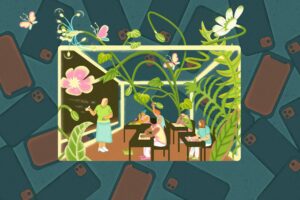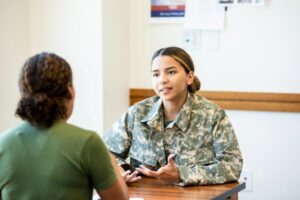
4-Year-Olds Pose Messy Challenge for Elementary Schools: Toilet-Training
More 4-year-olds across California are entering transitional kindergarten (TK) this year — curious and eager to play and learn. But some aren’t fully potty-trained, posing an unexpected challenge for schools.
“They are younger, and they’re going to have more accidents,” said Elyse Doerflinger, a TK teacher in the Woodlake Unified School District in Tulare County. “Then what?”
It’s a question school districts across the state are grappling with as they expand TK to younger children.
Once designed to serve only children who missed the kindergarten age cutoff, transitional kindergarten, often referred to as TK, has expanded to include all 4-year-olds, including those who turn 4 on Sept. 1.
Teaching children through play is one thing, but handling potty issues is another. There’s state guidance, but with little to no local direction, toileting practices differ across the board.
Private preschools vary in their approach to toilet-training. Many programs train preschool teachers to help children with toileting while others require children to be potty-trained before enrolling. Public schools cannot require students to be toilet-trained, but elementary school teachers are often not trained to help.
Most districts have adopted a hands-off approach for staff to work with TK students who have an accident, which relies on verbal guidance to talk to a student through the bathroom door when changing out of soiled clothes. When that fails, those students must wait for their parents to come to campus and help, disrupting everyone’s learning.
“You can’t hold down a job if you’re constantly being called to the school to get your kid,” Doerflinger said.
Other districts have created procedures to support students through toileting plans or special education services. Some teachers, without district guidance, have found ways to help their students as best as they can.
But there’s not one model that will work for all districts, schools, or even classrooms, said Patricia Lozano, executive director of the advocacy group Early Edge California.
‘We Do Not Wipe’
“Can you come wipe me?” a Fresno Unified School District TK student yelled out last week from the connected bathroom in Kristi Henkle’s class.
“We don’t do that,” she responded.
“Who’s going to do it?” the student quickly replied. It was the third day of school.
Educators in TK frequently remind young learners to use the restroom, wash their hands and flush the toilet, among other bathroom etiquette, like putting toilet paper, not paper towels, into the toilet.
But wiping students, many educators say, is well beyond those tasks.
“We do not wipe,” said Shawna Adam, a TK teacher in Hacienda La Puente Unified School District in Los Angeles County. “Our aides are not trained; neither are we as teachers for doing potty training. We’re not going to be trained in doing toileting and wiping. I am a general ed teacher.”
Although aides or paraprofessionals work alongside teachers to share responsibilities for serving young students, who will assist with wiping depends on the school district, its toileting practices for TK and labor contract language.
In many cases, a certain paraeducator is paid more to assist with wiping or changing.
“A lot of kids are not fully potty-trained,” Oakland Unified School District TK teacher Amairani Sanchez said. She has 24 students and two aides this year because the student-staff ratio for TK went down to 10-to-1. “Now that I have that second aide, if a kid needs help wiping, my para does that.”
According to the California Department of Education’s 32-page toileting toolkit, districts and schools should engage with union representatives about “which jobs will include direct toileting support activities, such as assisting a child with changing clothing or cleaning themselves.”
While contract language often dictates duties, if that isn’t specified, local district guidance or policy is necessary for educators to rely on — if it exists.
The Madera Unified School District’s two-page toileting guidance instructs its educators to verbally guide children through the process of changing into clean clothes if they wet themselves, or to discreetly send them to the office in the event of a bowel movement accident. That is the go-to strategy in other districts, such as Hacienda La Puente Unified.
“If there are accidents, (your) child (must) be able to take off their soiled clothing by themselves and we’ll give them wipes. If there’s No. 2, then, that’s on you; we call you to come down and change them,” Adam bluntly tells TK parents.
Despite how much teachers may want to help a student in soiled clothes, most are wary of disciplinary action from their district or lawsuits from the student’s family.
Not enough districts have clear guidance with systems and supports in place for teachers to overcome the challenges created by the expansion of TK.
“Teachers across the state, in their unions, are fighting and advocating for more resources for our youngest students,” said David Goldberg, president of the California Teachers Association.
Proper Facilities Necessary
Without contract language or local guidance, educators sometimes reach a consensus on their own.
Special education paraprofessionals, who are often tasked with supporting children who are still in diapers, have helped general education teachers and aides create toileting resources for the classroom.
The special education teacher will “put men’s boxers over her own clothes to demonstrate how to pull your pants down,” Doerflinger said about the teacher at her school. “She’ll take paper plates and smear peanut butter all over and have the kids practice wiping it off. They learn you have to do it until it’s clean all the way.”
Even for districts that have adopted approaches, such as opt-in forms on whether students can be helped with toileting, educators need more than just guidance to handle it.
Teachers and aides require supplies, such as wipes and gloves, as well as a trash can for the proper disposal of materials.
Schools also need the right kinds of facilities.
In some schools, TK classrooms do not have their own bathrooms, and the young children must use the same bathroom as all other students. In such cases, educators are unable to guide a child through the process of cleaning and dressing themselves.
In one elementary bathroom, a naked TK student runs to the door each day, carrying her clothes because she doesn’t know how to put them back on.
That’s one of many reasons why having a bathroom in the TK classroom is ideal for 4-year-olds.
A lack of state funding impacted districts’ ability to add toilets and bathrooms for them.
California voters in November approved $40 billion in local construction bonds and $10 billion in a statewide bond for facilities, but none of those funds are exclusively for transitional kindergarten. Because districts are also struggling to meet facilities needs, such as outdated or deteriorating buildings, TK will likely not take priority.
Many school districts still report that facilities, including developing age-appropriate bathrooms connected to classrooms, are a top challenge in implementing universal prekindergarten, according to a June 2025 Learning Policy Institute report.
At Greenberg Elementary School in Fresno Unified, for example, one TK classroom has a bathroom, while the other doesn’t. The other classroom on campus with a bathroom is for kindergarten students, who also require smaller toilets.
Students in classes with attached bathrooms have the freedom to go on their own schedules. Those who do not have an in-class restroom, however, must follow a stricter schedule with all of them going to the bathroom at once or must trek to the elementary bathroom with an aide.
“The intention of having a second adult in the classroom is for them to be a second teacher,” not “the walker to the bathroom,” said Hanna Melnick, director of early learning policy at Learning Policy Institute. “It defeats the purpose.”
Two dozen students being on the same potty schedule, teachers say, can also lead to more mishaps, so teachers must quickly get students in and out to avoid a potty accident.
A Partnership With Families
Before this school year, there was a premise that 4-year-olds who were not potty-trained needed an individualized education plan (IEP) for special education services, which required an aide for changing diapers and helping with toileting.
But that shouldn’t be the norm, some teachers and experts say.
“If you actually think there could be a disability, then let’s assess and check,” said Doerflinger, the TK teacher in Woodlake Unified who has one student who is not potty-trained and has been identified as having special needs and another student in the process of being recognized for such services. “Some kids just have trauma. Some kids just take longer. Some kids are terrified of a bathroom with a loud flushing toilet.”
While there will need to be a mindset shift among educators who believe all students who are not potty-trained need special education services, teachers and experts agree that families should play an active role in potty training their 4-year-olds.
In Los Angeles Unified, the state’s largest school district, toileting is considered a team effort between families and schools, said Pia Sadaqatmal, the district’s chief of transitional programs.
For students to have “toileting independence,” they should have opportunities to practice their toileting skills and exercise that independence, she said, noting frequent bathroom reminders and breaks at school, step-by-step picture guides once in the restroom, and books, instructional materials and resources shared with families to support toileting at home.
By sharing resources with families, “we’re all using the same language from the time the child wakes up in the morning until the time the child goes to bed at night,” said Ranae Amezquita, the district’s early childhood education director.
“We say, ‘Are kids ready for school?’ Also, ‘Are our schools ready for kids?’” said Lozano with Early Edge. “That is something that schools need to think about.”
Source link



